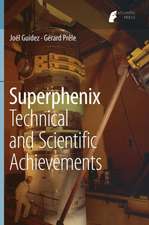A Study of the Fukushima Daiichi Nuclear Accident Process: What caused the core melt and hydrogen explosion?
Autor Michio Ishikawaen Limba Engleză Paperback – 26 aug 2015
Preț: 391.22 lei
Nou
Puncte Express: 587
Preț estimativ în valută:
74.90€ • 78.15$ • 62.78£
74.90€ • 78.15$ • 62.78£
Carte disponibilă
Livrare economică 19 februarie-05 martie
Preluare comenzi: 021 569.72.76
Specificații
ISBN-13: 9784431555421
ISBN-10: 4431555420
Pagini: 300
Ilustrații: XVI, 231 p. 39 illus., 36 illus. in color.
Dimensiuni: 155 x 235 x 17 mm
Greutate: 0.49 kg
Ediția:1st ed. 2015
Editura: Springer
Colecția Springer
Locul publicării:Tokyo, Japan
ISBN-10: 4431555420
Pagini: 300
Ilustrații: XVI, 231 p. 39 illus., 36 illus. in color.
Dimensiuni: 155 x 235 x 17 mm
Greutate: 0.49 kg
Ediția:1st ed. 2015
Editura: Springer
Colecția Springer
Locul publicării:Tokyo, Japan
Public țintă
ResearchCuprins
Three Mile Island nuclear power plant accident.- Fukushima Daiichi units 1,2 and 3 accidents.- Fukushima Daiichi unit 4 accident.- Radioactive release and resident evacuation.- Tsunami and loss of total electricity.- Reconstruction of nuclear safety.- Road to decommissioning.- Conclusion of the study.- Advices on the basis of the study.
Notă biografică
Dr. Ishikawa has more than 50 years of experiences in the area of nuclear power generation and its safety. He started to work in 1957 in Japan Atomic Energy Research Institute, for construction and operation of Japan Power Demonstration Reactor (JPDR), 15 MW Boiling Water Reactor (BWR), which was the first nuclear power plant in Japan. After that, he joined in Special Power Excursion Reactor Test Program (SPERT) project, NRTS, in U.S.A. He worked for nuclear safety, especially leading fuel behavior program, Nuclear Safety Research Reactor (NSRR), and safety analysis. In addition, he had an unique experience to direct decommissioning work of The Japan Power Demonstration Reactor (JPDR), Japan Atomic Energy Research Institute (JAERI) which was one of the pioneer works in the world. He was assigned the Professor in Hokkaido University in 1991, and the Technical Adviser of Nuclear Power Engineering Corporation in 1997. He served as the Advisory member of Nuclear Safety Commission (NSC), Nuclear and Industrial Safety Agency (NISA) in Japan, for 30 years as well as contributed a member of international meetings and advisory groups at Organization for Economic Cooperation and Development/Nuclear Energy Agency (OECD/NEA) and the International Atomic Energy Agency (IAEA). From 2005, he served as a president for 3 years at Japan Nuclear Technology Institute, and then, he acceded to Chief Adviser from March, 2008 to Sep. 2012 at Japan Nuclear Technology Institute (JANTI).
Textul de pe ultima copertă
Written by an expert in the field, this book is perfect for those who would like to know what happened at the Fukushima Daiichi Nuclear Power Plant. Part 1 of the book studies how core melts occurred in Fukushima Daiichi units 1, 2, and 3, respectively, based on evidence from the Three-Mile Island core melt accident and fuel behavior experiments performed in the 1970s under the cooperation between the United States, Germany, and Japan. This information explains the accident processes without contradicting data from Fukushima, which was published in the TEPCO report. The hydrogen explosions in units 1, 3, and 4 are also explained logically in conjunction with the above core melt process. Part 2 clarifies how the background radiation level of the site doubled: The first rise was just a leak from small openings in units 1 and 3 associated with fire-pump connection work. The second rise led to direct radioactive material release from unit 2. Evacuation dose adequacy and its timing are discussed with reference to the accident process, and the necessity for embankments surrounding nuclear power plants to increase protection against natural disasters is also discussed. New proposals for safety design and emergency preparedness are suggested based on lessons learned from the accident as well as from new experiences. Finally, a concept for decommissioning the Fukushima site and a recovery plan are introduced.
Caracteristici
Fukushima accident processes are identified logically based on the past similar accidents facts and safety experimental results Identifies the route and the igniter of hydrogen gas which destroyed reactor buildings Decontamination effect of SC vent is proved by analysis of site radiation data in accident Includes supplementary material: sn.pub/extras



























